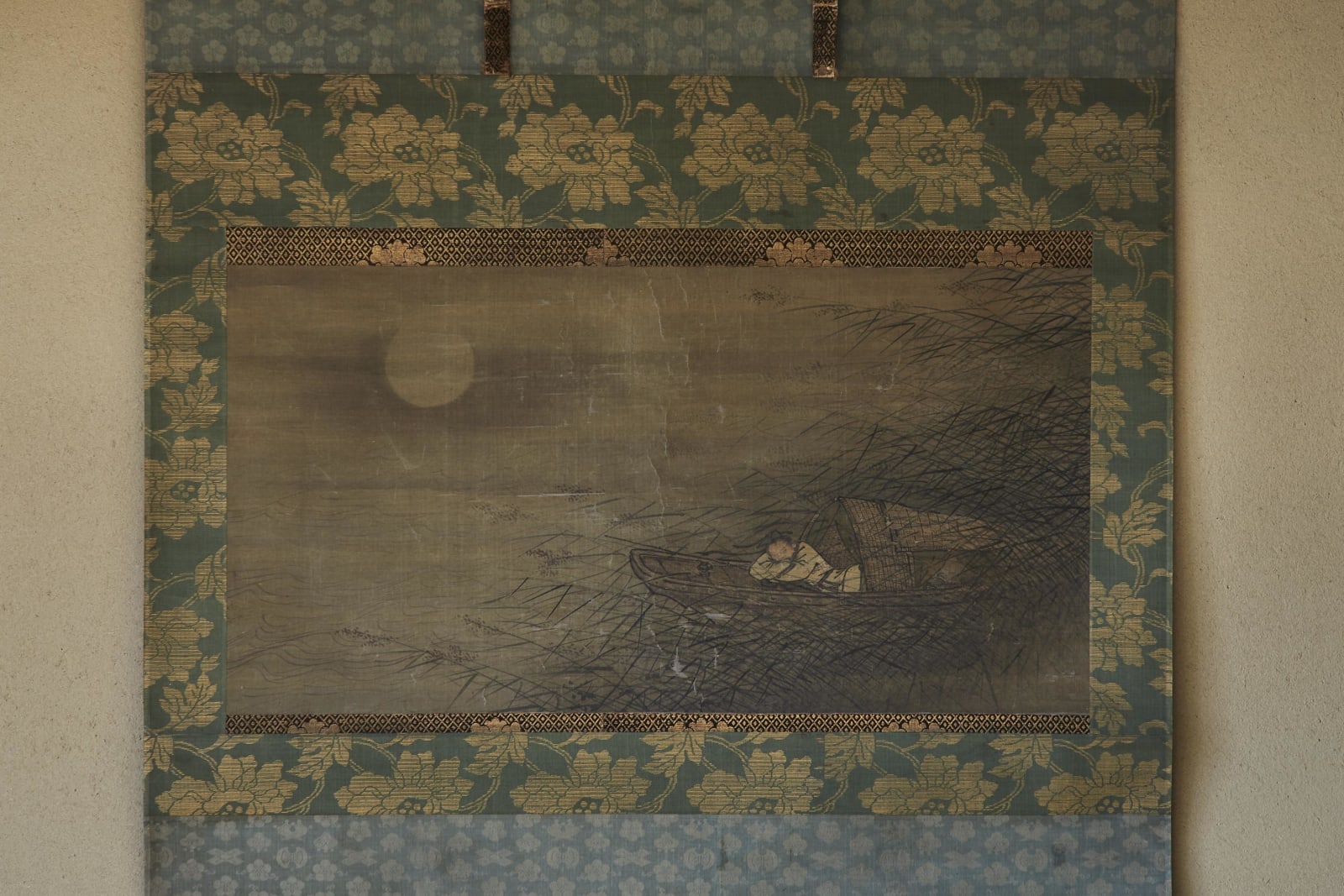Attributed to Dai Jin
Sleeping on a Boat Within the Reeds
Color on silk, hanging scroll
With box authentication by Tani Buncho
43.8 x 84.4 cm
148 x 101 cm (overall)
With box authentication by Tani Buncho
43.8 x 84.4 cm
148 x 101 cm (overall)
Further images
Provenance
Collection of the Makino clanExhibitions
Nihon meiho tenrankai. Tokyo: Tokyo Prefectural Art Museum, 1929.Toyo bijutsu dai tenrankai. Osaka: Osaka City Museum of Fine Arts, 1938.
Kokuho butsuzo oyobi meiho tokubetsu tenkan. Kasama: Kasama Bijutsukan, 1950.
Kuraishi-ke zohin nyusatsu. Tokyo: Tokyo Art Club, 1972.
Literature
Kokka, no. 171. Tokyo: Kokka-sha, 1904.Minga. Vol. 13 of Shinko gasui. Tokyo: Shinko Gasui-sha, 1920.
Nihon meiho monogatari. Tokyo: Seibun-do, 1929.
According to a box inscription by Tani Buncho during the Kansei period, Kokka no. 171 attributed this painting to Dai Jin and said it was inspired by In a Riverside Village, a poem by the Chinese poet Sikong Shu (b. 740). The poem reads thus; “Returning from fishing, the angler does not moor his boat. / As the moon sets over the riverside village, it becomes the perfect time for sleeping. / Even if the wind blows the boat away at night, / it will just drift around the shallow waters where the reeds bloom.” This may seem an unusual theme for a painting, but it also provided the inspiration for several other works, including Tani Buncho’s Sleeping on a Boat Within the Reeds (as found in Nanga-shu ge), Kano Eino’s fusuma-e painting in the Jumyo-in Sub-temple of Enkyo-ji Temple, and Soga Shohaku’s Taigong Wang (Hakutakuan Collection). The latter half of the poem is inscribed on a painting of the same theme in Suzuki Fuyo’s illustrated book Gazu suifuyo.
The poem is also thought to provide the theme for Staying in a Boat under the Moon (C. C. Wang Collection), a work bearing Dai Jin’s signature (Suzuki Kei’s Chugoku kaiga shi ge actually mentions the existence of a very similar work). Though the depiction of the reeds is similar in both pictures, the boat and the angler are both portrayed with more color and realism in this painting. Furthermore, in the other work the angler’s clothes are depicted with a mixture of thick and thin lines in the manner of the Zhe school, though this trait is absent here.
As the reeds and the boat overlap in the bottom-right foreground, they imbue the work with a sense of presence. The absence of mountains, rocks, pine trees and other common motifs from Chinese paintings also lend the work a sense of novelty and freshness. Whether this was painted by Dai Jin or not, it is without doubt an extremely unique work of art. It may also date back to before the time Dai Jin was active during the early fifteenth century.
Dai Jin (painter; 1388–1462)
Also known as Wenjin; Jing’an; Yuquan-shanren.
Early Ming painter. Born in Qiantang, the current Hangzhou, Zhejiang, China. Served the Emperor Xuande as a court artist, later was expelled from the imperial painting academy due to slanders, and became a recluse in his hometown. Developed an original painting style that integrates the Southern Song academic style with the manners of other painting schools of the Northern Song and Yuan dynasties, including the Li-Guo School. Recognized as the founding father of the Zhe School, whose painting style is followed by numerous artists.
The poem is also thought to provide the theme for Staying in a Boat under the Moon (C. C. Wang Collection), a work bearing Dai Jin’s signature (Suzuki Kei’s Chugoku kaiga shi ge actually mentions the existence of a very similar work). Though the depiction of the reeds is similar in both pictures, the boat and the angler are both portrayed with more color and realism in this painting. Furthermore, in the other work the angler’s clothes are depicted with a mixture of thick and thin lines in the manner of the Zhe school, though this trait is absent here.
As the reeds and the boat overlap in the bottom-right foreground, they imbue the work with a sense of presence. The absence of mountains, rocks, pine trees and other common motifs from Chinese paintings also lend the work a sense of novelty and freshness. Whether this was painted by Dai Jin or not, it is without doubt an extremely unique work of art. It may also date back to before the time Dai Jin was active during the early fifteenth century.
Dai Jin (painter; 1388–1462)
Also known as Wenjin; Jing’an; Yuquan-shanren.
Early Ming painter. Born in Qiantang, the current Hangzhou, Zhejiang, China. Served the Emperor Xuande as a court artist, later was expelled from the imperial painting academy due to slanders, and became a recluse in his hometown. Developed an original painting style that integrates the Southern Song academic style with the manners of other painting schools of the Northern Song and Yuan dynasties, including the Li-Guo School. Recognized as the founding father of the Zhe School, whose painting style is followed by numerous artists.









